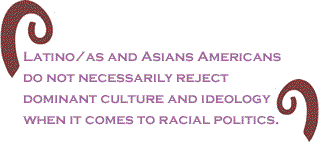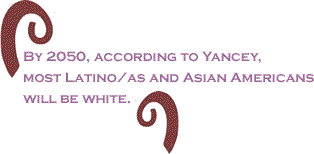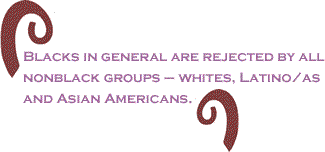
|
|||||||||||||||||||||
|
A Review of Who is White?: Latinos, Asians, and the New Black/Nonblack Divide by George Yancey (Boulder, CO: Lynne Rienner Publishers, 2003). In 1903 the ever-forward looking W.E.B. DuBois declared, “The problem of the twentieth century is the problem of the color line.” A century later, the relevance of DuBois’ observation is being contested by those preoccupied with the increasing ethnic and cultural diversification of the US. Many argue that DuBois’ centralization of the boundary between the entangled black and white worlds is outdated, going so far as to propose that we now have “colorlines.” Such gestures are more than semantic and instead imply that blackness as the definitive social boundary for US race relations is either less pronounced or completely erased by the significant presence of nonblack racial minorities such as Latino/as and Asian Americans. This is precisely why George Yancey’s book Who is White?: Latinos, Asians, and the New Black/Nonblack Divide is such a necessary read. Yancey, a sociologist at the University of North Texas, provides compelling evidence that supports the (unstated) hypothesis that the color line of the twentieth century will remain firmly entrenched in the twenty-first. Using as his point of departure the popular projection that whites will soon be a minority group, Yancey opens his book by arguing that whites will remain the majority despite the growing populations of Latino/as and Asian Americans. How can the increase of Latino/as and Asian Americans enforce, rather than disrupt, the color line? Simple. By 2050, according to Yancey, most Latino/as and Asian Americans will be white. For those who consider race to be a biological fact rather than a social and political one, Yancey’s projection is sure to raise eyebrows. Yet his argument is grounded in an understanding of how whiteness, like any racial category, is socially and politically defined yet enacted in real and meaningful ways. Whiteness is also fluid and maintains itself when threatened by incorporating previously excluded groups. In the chapter “How to be White,” Yancey covers ground commonly discussed by practitioners of what is becoming institutionalized as “whiteness studies,” including the racialized discrimination and nativism that different European ethnic groups faced before they eventually became socially accepted by Anglos and then later by a more expansive pan-European race simply known as “white.”
Since it is generally argued that these ethnic groups were able to assimilate into whiteness because they had similar phenotypes and could trace their roots to Europe – a point Yancey acknowledges – what makes Who is White? so provocative is its author suggests that European phenotype or ancestry will no longer be prerequisites for becoming white. While the US Census Bureau treats Latino/as as an “ethnic group” of sorts by emphasizing Latin American origin, many are socially read as “brown.” Most Asian Americans are markedly non-European in phenotype and ancestry. Nevertheless, Yancey argues that while they may experience patterns of discrimination and racism from whites, both Latino/as and Asian Americans are following the same pattern of assimilation as Europeans did before them. Grounding his study within the framework of noted sociologist Milton Gordon, whose work on assimilation emphasized social acceptance by the majority and identification with it from the minority, Yancey provides compelling evidence indicating that Latino/as and Asian Americans are well on their way to becoming white. In the chapter “They are Okay – Just Keep Them Away from Me,” the author analyzes survey data on racial groups’ social attitudes regarding who they approve as potential neighbors as well as marriage partners for their children. Contrary to the popular image of blacks as racially restrictive, Yancey discovers that black respondents are the most open to all other races. Yet despite being the most receptive to other groups, blacks in general are rejected by all nonblack groups – whites, Latino/as and Asian Americans. While some assume that whites will be closed off to anyone not white, Yancey’s research show that white respondents are more accepting of Latino/as and Asian Americans than they are of blacks. In turn, Latino/a and Asian American respondents are fairly receptive to one another as well as whites. Overall, Yancey’s findings reveal that whites, Latino/as and Asian Americans do not tend to reject one another as possible neighbors or their kids’ spouses, but all three groups show a general resistance to blacks in these social roles.
That all three nonblack groups were found to be more accepting of one another in a way that they were not of blacks suggests that assimilation may be less about desiring whiteness as it is avoiding blackness. Yancey concludes, “The rejection of African Americans, rather than the acceptance of European Americans, is the best explanation of social distance in the United States.” This assessment will surely be criticized for being “pro assimilationist,” a response Yancey anticipates: “It is debatable whether assimilation is a desirable goal for racial minority groups. I do not take a position either way. However, understanding the ability of a given minority group to assimilate is necessary for determining the degree of acceptance experienced by that minority group.” Another criticism of Yancey’s work may come from those who argue that Latino/as and Asian Americans are different from whites based upon cultural norms. Such proponents may think that Yancey’s emphasis on majority acceptance gives “whites too much power” by ignoring Latino/as’ and Asian Americans’ distinct cultures or worldviews. Yet Yancey shows that despite their supposed cultural differences from the white majority, Latino/as and Asians Americans do not necessarily reject dominant culture and ideology when it comes to racial politics. For example, Yancey shows that, for the most part, Latino/as and Asian Americans express dimensions of what he labels a white racial identity, which, according to the sociologist, emphasizes individualism, color-blindness or an aversion to dealing with race, and a belief in European cultural normativity. Analyzing survey data measuring respondents’ opinions of “racialized” issues such as affirmative action, prison spending, welfare, and talking about race, Yancey determines that, even when controlling for social and demographic characteristics, “there was no situation where the nonblack minority groups differed significantly in a direction opposite from that by which European Americans differed from African Americans.” In other words, black respondents were the only group to demonstrate a “distinct” worldview – due, according to Yancey, from experiencing an intense amount of social alienation. Conversely, Latino/a and Asian American respondents did not significantly distinguish their opinions from those held by white respondents. This finding suggests that despite their current status as non-whites, Latino/as and Asian Americans are more apt to hold a white world view than a black one. Overall, while some will surely dismiss Who is White? as “academic” – a practice many activists and even academics engage in when confronted with political conclusions that make them uncomfortable – Yancey’s research is extremely relevant for contemporary racial politics. Most importantly, Yancey’s findings hint at possible inadequacies of current approaches to “multiracial” America, most of which emphasize a white/non-white paradigm that minimizes or outright dismisses the reality of antiblack racism as the structuring and generative ideology of US race relations and social inequality.
Thus, Who is White? is more than a rich sociological study; it also serves as a blueprint for the political possibilities that lie before us if left unaddressed. In the final chapter, Yancey leaves us with a concluding remark that will hopefully be appreciated for its DuBoisian approach, which is one that challenges today’s activists and intellectuals to not only deal with the past and present, but also with the very real possibilities of America’s racial future: “Previous research on majority group domination tends to be built upon either the concept that white supremacy is, or was, the dominant ideology among majority group members, or the concept that dominant group members utilize notions of color blindness to protect their racial position of privilege. Both concepts lead to an understanding of an American racial hierarchy formed by a white/nonwhite dichotomy. In such a system all non-European groups face social rejection and theoretically all non-European groups deserve an equal amount of academic attention – even if they have not been receiving it. Yet given the merging of nonblack racial minorities into the dominant culture, this white/nonwhite dichotomy is losing relevance. A black/nonblack dichotomy produces more understanding about contemporary race relations. It suggests that the informal rejection of African Americans, rather than a tendency by the majority to oppress all minority groups in a roughly equal manner, is the linchpin to the American contemporary racial hierarchy.” Tamara K. Nopper is a Ph.D. candidate in sociology at Temple University in Philadelphia. She is currently working on her dissertation which explores the different sources of capital and resources available to Korean immigrants to open, run and expand small businesses in the US. Contact her at [email protected]. Copyright © 2005 Tamara K. Nopper |
Your comments are always welcome. Visit the Contact Us page to send e-Mail or Feedback or Click here to send e-Mail to [email protected] e-Mail re-print notice
If you send us an e-Mail message we may publish all or part of it, unless you tell us it is not for publication. You may also request that we withhold your name. Thank you very much for your readership. |
| May 12 2005 Issue 138 |
|||||||||
|
|||||||||
|
|
|||||||||
| Printer Friendly Version | |||||||||
 |
|||||||||
 |
|||||||||
| |
|||||||||
| |
|||||||||




























